A Study to Analyze Factors Impacting Solar Energy Auction Prices
VerifiedAdded on 2022/11/13
|60
|19566
|303
Thesis and Dissertation
AI Summary
This dissertation examines the factors that influence solar energy auction prices in India. The study begins with an introduction to the importance of solar energy as a renewable resource and the role of auctions in India's energy market. It investigates the background of solar energy, the rationale for the study, and the research problem, aim, objectives, and questions. A comprehensive literature review explores solar energy production, auctions, and the various factors affecting auction prices, including financial considerations, investor confidence, energy demand, resource availability, and alternative energy sources. The research methodology chapter details the research philosophy, approach, design, data collection methods, and analysis techniques used. The findings are presented through descriptive and inferential analyses, including correlations and regressions. The discussion chapter analyzes the findings in relation to existing literature, while the conclusion summarizes the key findings, links them to the research objectives, and provides recommendations for future research and policy implications. The study highlights the significance of factors such as solar energy demand, availability of resources, and alternative energy sources in determining auction prices, offering valuable insights for the Solar Energy Corporation of India (SECI) and policymakers to enhance solar energy production.
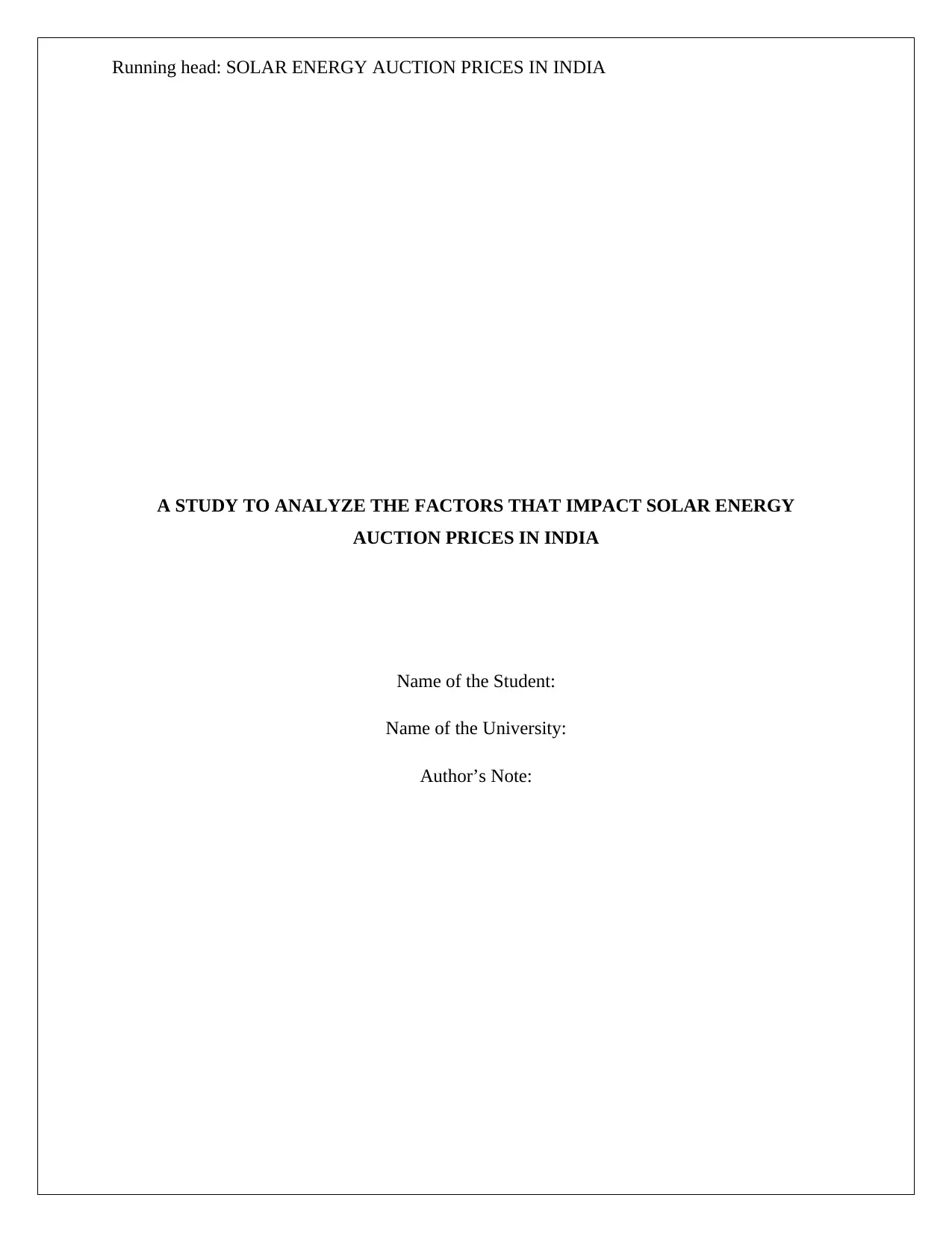
Running head: SOLAR ENERGY AUCTION PRICES IN INDIA
A STUDY TO ANALYZE THE FACTORS THAT IMPACT SOLAR ENERGY
AUCTION PRICES IN INDIA
Name of the Student:
Name of the University:
Author’s Note:
A STUDY TO ANALYZE THE FACTORS THAT IMPACT SOLAR ENERGY
AUCTION PRICES IN INDIA
Name of the Student:
Name of the University:
Author’s Note:
Paraphrase This Document
Need a fresh take? Get an instant paraphrase of this document with our AI Paraphraser
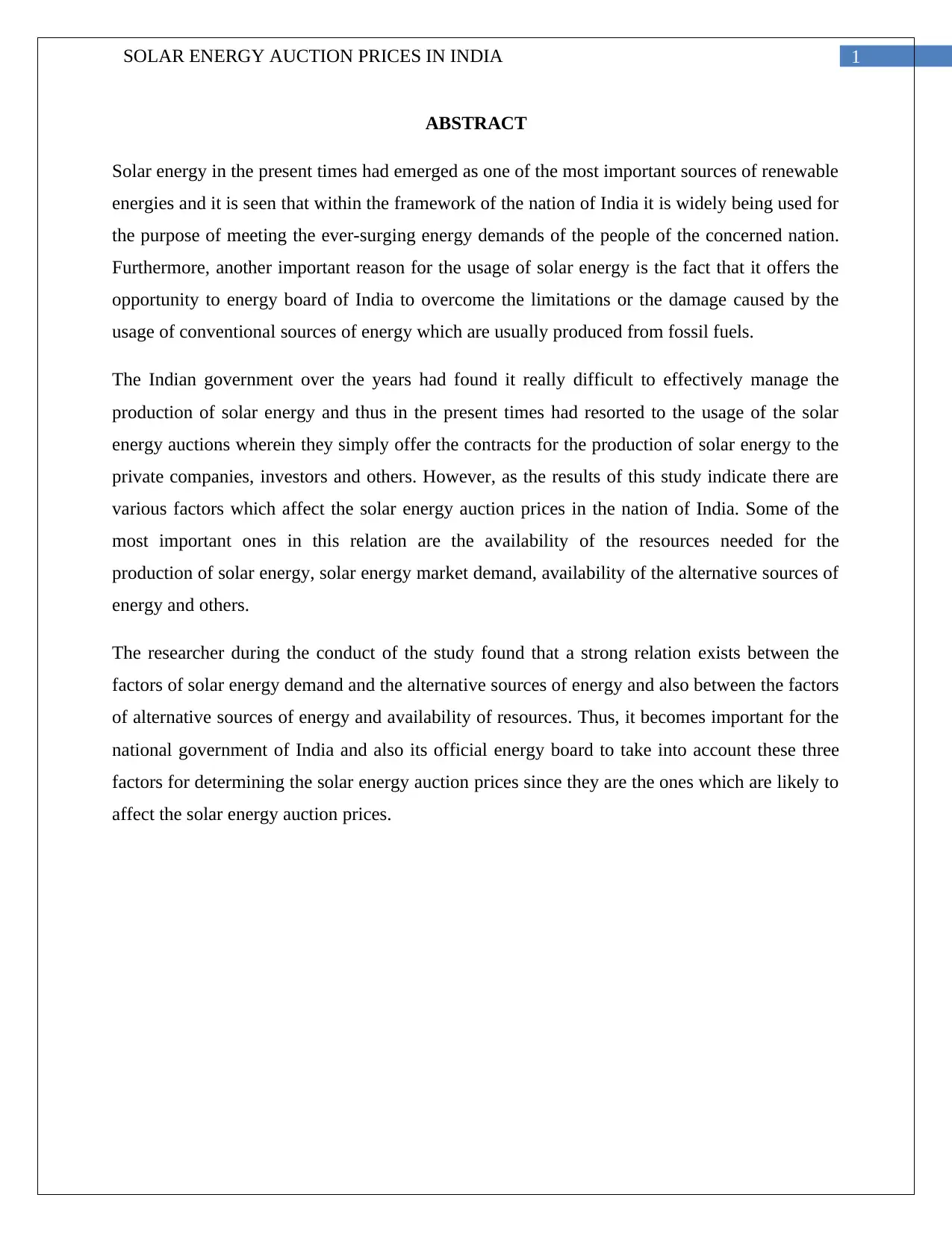
1SOLAR ENERGY AUCTION PRICES IN INDIA
ABSTRACT
Solar energy in the present times had emerged as one of the most important sources of renewable
energies and it is seen that within the framework of the nation of India it is widely being used for
the purpose of meeting the ever-surging energy demands of the people of the concerned nation.
Furthermore, another important reason for the usage of solar energy is the fact that it offers the
opportunity to energy board of India to overcome the limitations or the damage caused by the
usage of conventional sources of energy which are usually produced from fossil fuels.
The Indian government over the years had found it really difficult to effectively manage the
production of solar energy and thus in the present times had resorted to the usage of the solar
energy auctions wherein they simply offer the contracts for the production of solar energy to the
private companies, investors and others. However, as the results of this study indicate there are
various factors which affect the solar energy auction prices in the nation of India. Some of the
most important ones in this relation are the availability of the resources needed for the
production of solar energy, solar energy market demand, availability of the alternative sources of
energy and others.
The researcher during the conduct of the study found that a strong relation exists between the
factors of solar energy demand and the alternative sources of energy and also between the factors
of alternative sources of energy and availability of resources. Thus, it becomes important for the
national government of India and also its official energy board to take into account these three
factors for determining the solar energy auction prices since they are the ones which are likely to
affect the solar energy auction prices.
ABSTRACT
Solar energy in the present times had emerged as one of the most important sources of renewable
energies and it is seen that within the framework of the nation of India it is widely being used for
the purpose of meeting the ever-surging energy demands of the people of the concerned nation.
Furthermore, another important reason for the usage of solar energy is the fact that it offers the
opportunity to energy board of India to overcome the limitations or the damage caused by the
usage of conventional sources of energy which are usually produced from fossil fuels.
The Indian government over the years had found it really difficult to effectively manage the
production of solar energy and thus in the present times had resorted to the usage of the solar
energy auctions wherein they simply offer the contracts for the production of solar energy to the
private companies, investors and others. However, as the results of this study indicate there are
various factors which affect the solar energy auction prices in the nation of India. Some of the
most important ones in this relation are the availability of the resources needed for the
production of solar energy, solar energy market demand, availability of the alternative sources of
energy and others.
The researcher during the conduct of the study found that a strong relation exists between the
factors of solar energy demand and the alternative sources of energy and also between the factors
of alternative sources of energy and availability of resources. Thus, it becomes important for the
national government of India and also its official energy board to take into account these three
factors for determining the solar energy auction prices since they are the ones which are likely to
affect the solar energy auction prices.

2SOLAR ENERGY AUCTION PRICES IN INDIA
ACKNOWLEDGEMENT
I would take this opportunity to thank my Professor, Mr. ………….for offer me to the
opportunity to complete my dissertation on the topic “A study to analyze the factors which affect
the solar energy auction prices in India”. Furthermore, I would also thank my Supervisor for the
constant support that I received from him during the completion of this dissertation.
Lastly, I would also like to thank my family members and friends for the support that they have
offered to me and without whom I would not have been able to complete this study.
Thank You,
------------------------------------------------------
(Name of the Researcher)
ACKNOWLEDGEMENT
I would take this opportunity to thank my Professor, Mr. ………….for offer me to the
opportunity to complete my dissertation on the topic “A study to analyze the factors which affect
the solar energy auction prices in India”. Furthermore, I would also thank my Supervisor for the
constant support that I received from him during the completion of this dissertation.
Lastly, I would also like to thank my family members and friends for the support that they have
offered to me and without whom I would not have been able to complete this study.
Thank You,
------------------------------------------------------
(Name of the Researcher)
⊘ This is a preview!⊘
Do you want full access?
Subscribe today to unlock all pages.

Trusted by 1+ million students worldwide
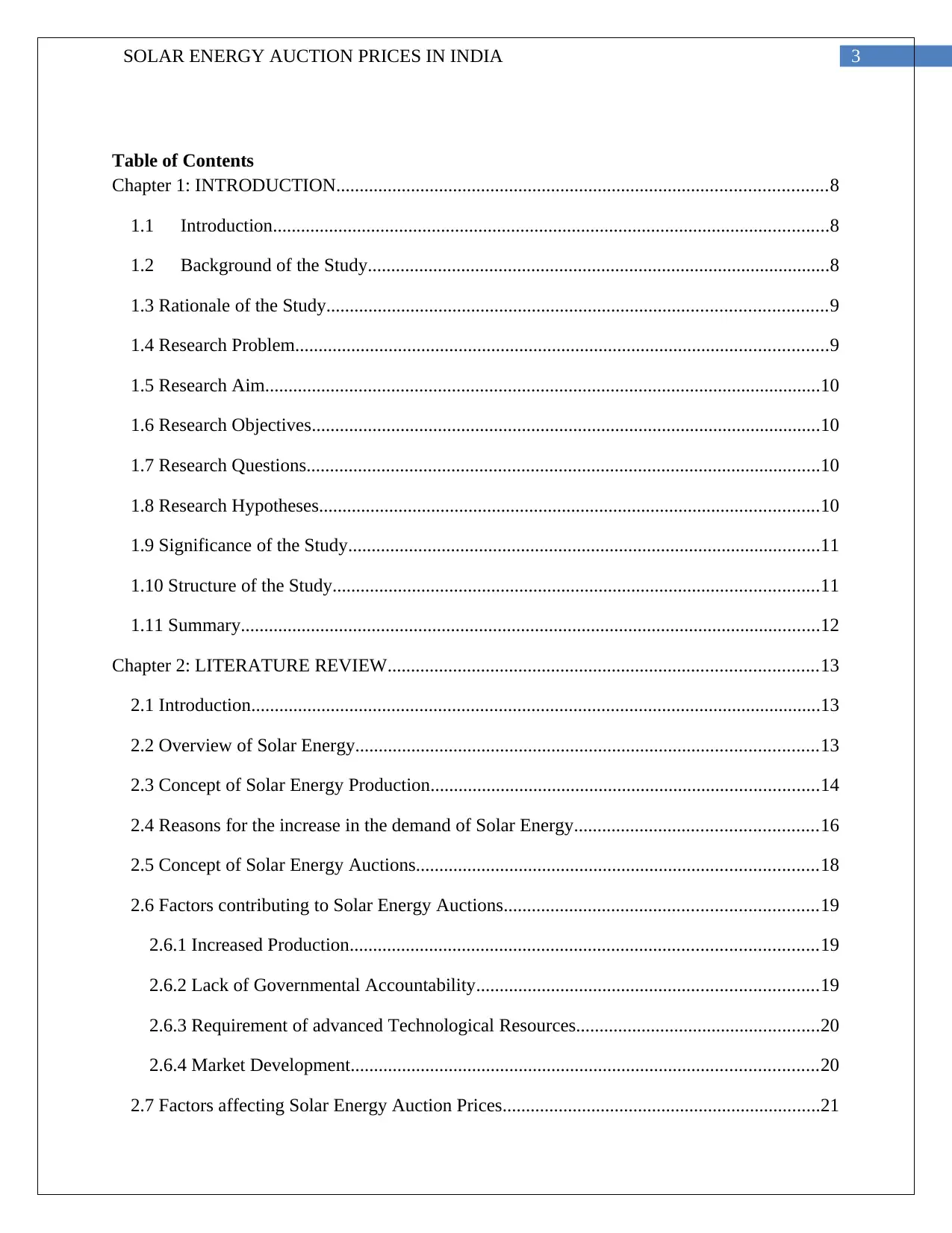
3SOLAR ENERGY AUCTION PRICES IN INDIA
Table of Contents
Chapter 1: INTRODUCTION.........................................................................................................8
1.1 Introduction.......................................................................................................................8
1.2 Background of the Study...................................................................................................8
1.3 Rationale of the Study...........................................................................................................9
1.4 Research Problem..................................................................................................................9
1.5 Research Aim.......................................................................................................................10
1.6 Research Objectives.............................................................................................................10
1.7 Research Questions..............................................................................................................10
1.8 Research Hypotheses...........................................................................................................10
1.9 Significance of the Study.....................................................................................................11
1.10 Structure of the Study........................................................................................................11
1.11 Summary............................................................................................................................12
Chapter 2: LITERATURE REVIEW............................................................................................13
2.1 Introduction..........................................................................................................................13
2.2 Overview of Solar Energy...................................................................................................13
2.3 Concept of Solar Energy Production...................................................................................14
2.4 Reasons for the increase in the demand of Solar Energy....................................................16
2.5 Concept of Solar Energy Auctions......................................................................................18
2.6 Factors contributing to Solar Energy Auctions...................................................................19
2.6.1 Increased Production....................................................................................................19
2.6.2 Lack of Governmental Accountability.........................................................................19
2.6.3 Requirement of advanced Technological Resources....................................................20
2.6.4 Market Development....................................................................................................20
2.7 Factors affecting Solar Energy Auction Prices....................................................................21
Table of Contents
Chapter 1: INTRODUCTION.........................................................................................................8
1.1 Introduction.......................................................................................................................8
1.2 Background of the Study...................................................................................................8
1.3 Rationale of the Study...........................................................................................................9
1.4 Research Problem..................................................................................................................9
1.5 Research Aim.......................................................................................................................10
1.6 Research Objectives.............................................................................................................10
1.7 Research Questions..............................................................................................................10
1.8 Research Hypotheses...........................................................................................................10
1.9 Significance of the Study.....................................................................................................11
1.10 Structure of the Study........................................................................................................11
1.11 Summary............................................................................................................................12
Chapter 2: LITERATURE REVIEW............................................................................................13
2.1 Introduction..........................................................................................................................13
2.2 Overview of Solar Energy...................................................................................................13
2.3 Concept of Solar Energy Production...................................................................................14
2.4 Reasons for the increase in the demand of Solar Energy....................................................16
2.5 Concept of Solar Energy Auctions......................................................................................18
2.6 Factors contributing to Solar Energy Auctions...................................................................19
2.6.1 Increased Production....................................................................................................19
2.6.2 Lack of Governmental Accountability.........................................................................19
2.6.3 Requirement of advanced Technological Resources....................................................20
2.6.4 Market Development....................................................................................................20
2.7 Factors affecting Solar Energy Auction Prices....................................................................21
Paraphrase This Document
Need a fresh take? Get an instant paraphrase of this document with our AI Paraphraser
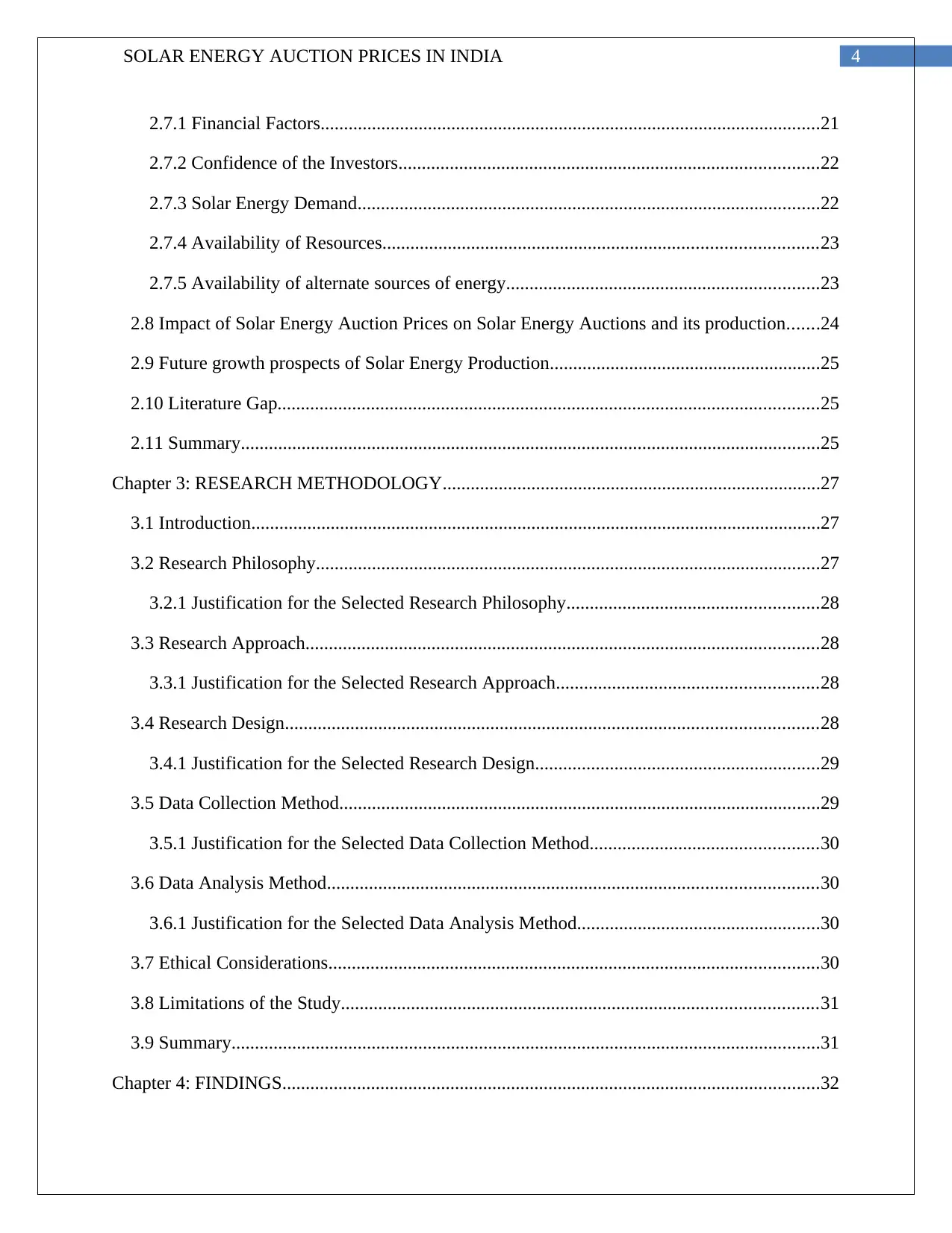
4SOLAR ENERGY AUCTION PRICES IN INDIA
2.7.1 Financial Factors...........................................................................................................21
2.7.2 Confidence of the Investors..........................................................................................22
2.7.3 Solar Energy Demand...................................................................................................22
2.7.4 Availability of Resources.............................................................................................23
2.7.5 Availability of alternate sources of energy...................................................................23
2.8 Impact of Solar Energy Auction Prices on Solar Energy Auctions and its production.......24
2.9 Future growth prospects of Solar Energy Production..........................................................25
2.10 Literature Gap....................................................................................................................25
2.11 Summary............................................................................................................................25
Chapter 3: RESEARCH METHODOLOGY.................................................................................27
3.1 Introduction..........................................................................................................................27
3.2 Research Philosophy............................................................................................................27
3.2.1 Justification for the Selected Research Philosophy......................................................28
3.3 Research Approach..............................................................................................................28
3.3.1 Justification for the Selected Research Approach........................................................28
3.4 Research Design..................................................................................................................28
3.4.1 Justification for the Selected Research Design.............................................................29
3.5 Data Collection Method.......................................................................................................29
3.5.1 Justification for the Selected Data Collection Method.................................................30
3.6 Data Analysis Method.........................................................................................................30
3.6.1 Justification for the Selected Data Analysis Method....................................................30
3.7 Ethical Considerations.........................................................................................................30
3.8 Limitations of the Study......................................................................................................31
3.9 Summary..............................................................................................................................31
Chapter 4: FINDINGS...................................................................................................................32
2.7.1 Financial Factors...........................................................................................................21
2.7.2 Confidence of the Investors..........................................................................................22
2.7.3 Solar Energy Demand...................................................................................................22
2.7.4 Availability of Resources.............................................................................................23
2.7.5 Availability of alternate sources of energy...................................................................23
2.8 Impact of Solar Energy Auction Prices on Solar Energy Auctions and its production.......24
2.9 Future growth prospects of Solar Energy Production..........................................................25
2.10 Literature Gap....................................................................................................................25
2.11 Summary............................................................................................................................25
Chapter 3: RESEARCH METHODOLOGY.................................................................................27
3.1 Introduction..........................................................................................................................27
3.2 Research Philosophy............................................................................................................27
3.2.1 Justification for the Selected Research Philosophy......................................................28
3.3 Research Approach..............................................................................................................28
3.3.1 Justification for the Selected Research Approach........................................................28
3.4 Research Design..................................................................................................................28
3.4.1 Justification for the Selected Research Design.............................................................29
3.5 Data Collection Method.......................................................................................................29
3.5.1 Justification for the Selected Data Collection Method.................................................30
3.6 Data Analysis Method.........................................................................................................30
3.6.1 Justification for the Selected Data Analysis Method....................................................30
3.7 Ethical Considerations.........................................................................................................30
3.8 Limitations of the Study......................................................................................................31
3.9 Summary..............................................................................................................................31
Chapter 4: FINDINGS...................................................................................................................32
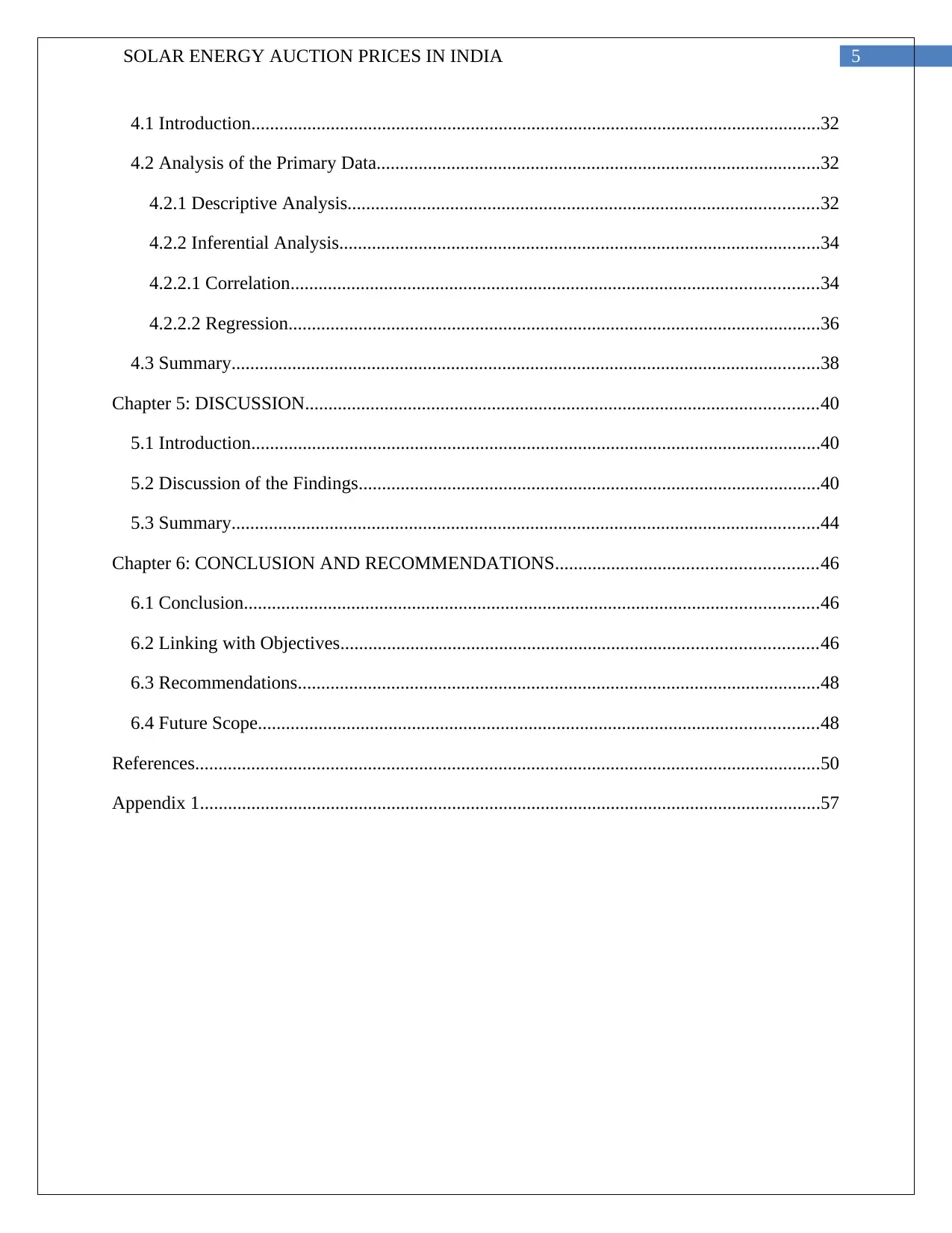
5SOLAR ENERGY AUCTION PRICES IN INDIA
4.1 Introduction..........................................................................................................................32
4.2 Analysis of the Primary Data...............................................................................................32
4.2.1 Descriptive Analysis.....................................................................................................32
4.2.2 Inferential Analysis.......................................................................................................34
4.2.2.1 Correlation.................................................................................................................34
4.2.2.2 Regression..................................................................................................................36
4.3 Summary..............................................................................................................................38
Chapter 5: DISCUSSION..............................................................................................................40
5.1 Introduction..........................................................................................................................40
5.2 Discussion of the Findings...................................................................................................40
5.3 Summary..............................................................................................................................44
Chapter 6: CONCLUSION AND RECOMMENDATIONS........................................................46
6.1 Conclusion...........................................................................................................................46
6.2 Linking with Objectives......................................................................................................46
6.3 Recommendations................................................................................................................48
6.4 Future Scope........................................................................................................................48
References......................................................................................................................................50
Appendix 1.....................................................................................................................................57
4.1 Introduction..........................................................................................................................32
4.2 Analysis of the Primary Data...............................................................................................32
4.2.1 Descriptive Analysis.....................................................................................................32
4.2.2 Inferential Analysis.......................................................................................................34
4.2.2.1 Correlation.................................................................................................................34
4.2.2.2 Regression..................................................................................................................36
4.3 Summary..............................................................................................................................38
Chapter 5: DISCUSSION..............................................................................................................40
5.1 Introduction..........................................................................................................................40
5.2 Discussion of the Findings...................................................................................................40
5.3 Summary..............................................................................................................................44
Chapter 6: CONCLUSION AND RECOMMENDATIONS........................................................46
6.1 Conclusion...........................................................................................................................46
6.2 Linking with Objectives......................................................................................................46
6.3 Recommendations................................................................................................................48
6.4 Future Scope........................................................................................................................48
References......................................................................................................................................50
Appendix 1.....................................................................................................................................57
⊘ This is a preview!⊘
Do you want full access?
Subscribe today to unlock all pages.

Trusted by 1+ million students worldwide
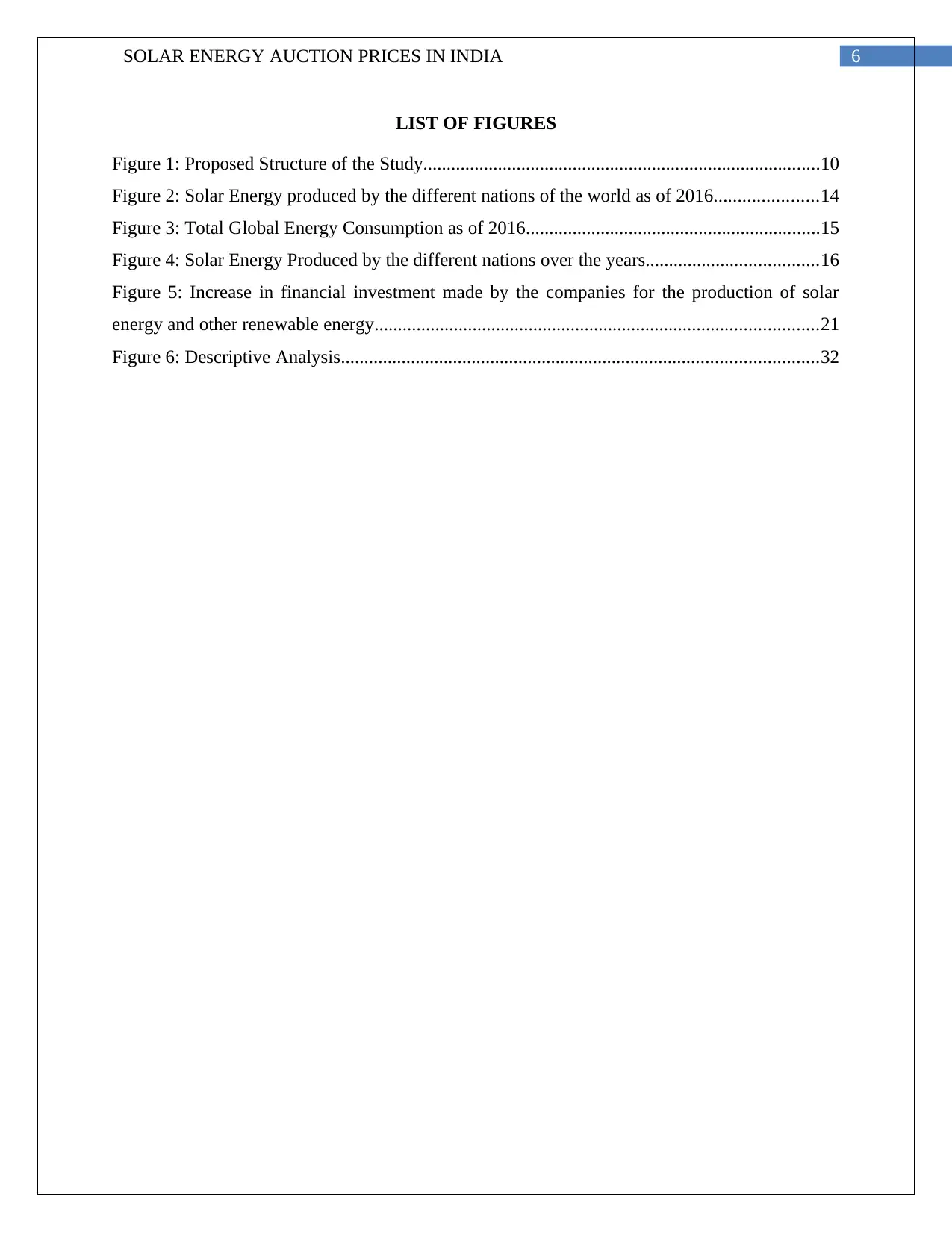
6SOLAR ENERGY AUCTION PRICES IN INDIA
LIST OF FIGURES
Figure 1: Proposed Structure of the Study.....................................................................................10
Figure 2: Solar Energy produced by the different nations of the world as of 2016......................14
Figure 3: Total Global Energy Consumption as of 2016...............................................................15
Figure 4: Solar Energy Produced by the different nations over the years.....................................16
Figure 5: Increase in financial investment made by the companies for the production of solar
energy and other renewable energy...............................................................................................21
Figure 6: Descriptive Analysis......................................................................................................32
LIST OF FIGURES
Figure 1: Proposed Structure of the Study.....................................................................................10
Figure 2: Solar Energy produced by the different nations of the world as of 2016......................14
Figure 3: Total Global Energy Consumption as of 2016...............................................................15
Figure 4: Solar Energy Produced by the different nations over the years.....................................16
Figure 5: Increase in financial investment made by the companies for the production of solar
energy and other renewable energy...............................................................................................21
Figure 6: Descriptive Analysis......................................................................................................32
Paraphrase This Document
Need a fresh take? Get an instant paraphrase of this document with our AI Paraphraser
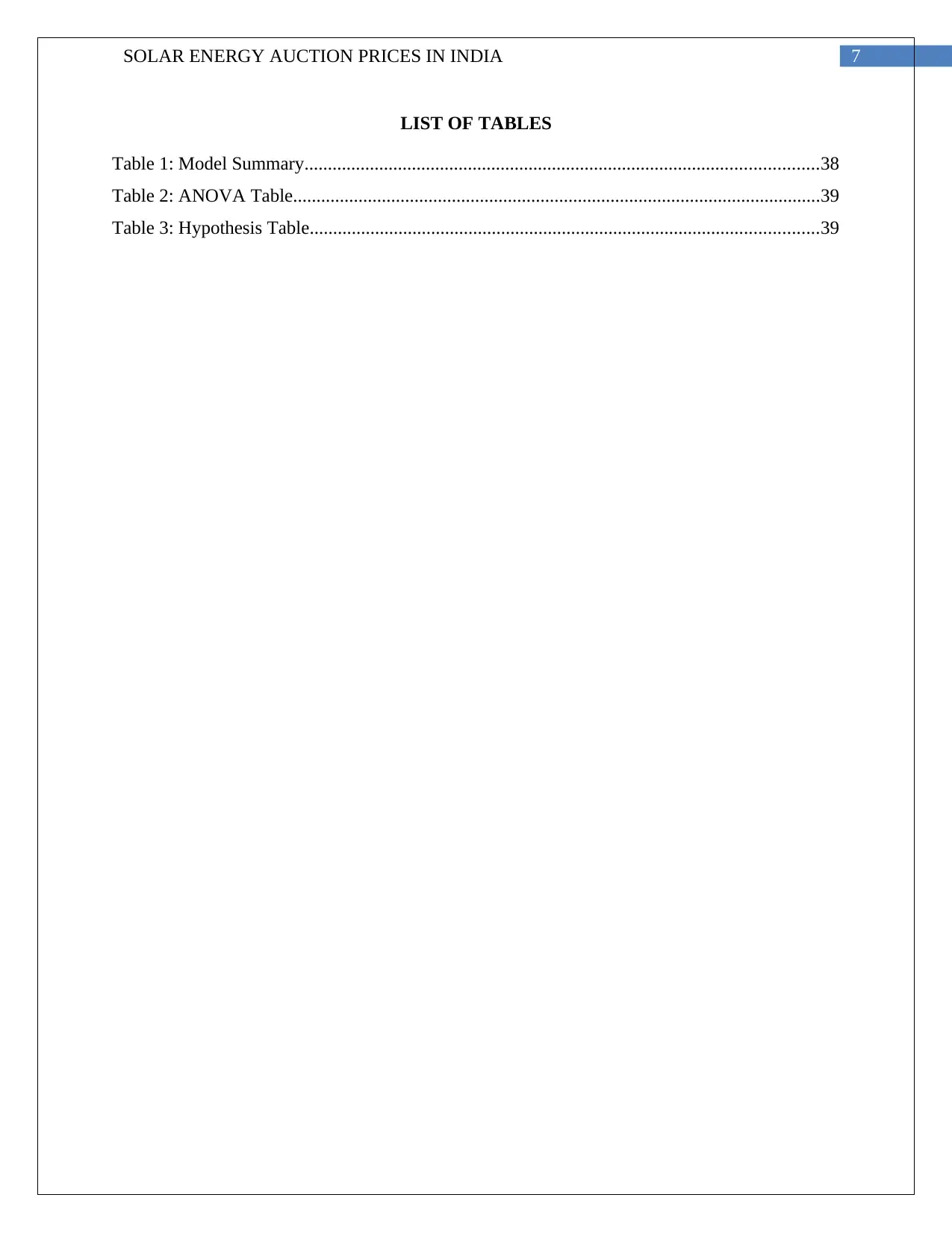
7SOLAR ENERGY AUCTION PRICES IN INDIA
LIST OF TABLES
Table 1: Model Summary..............................................................................................................38
Table 2: ANOVA Table.................................................................................................................39
Table 3: Hypothesis Table.............................................................................................................39
LIST OF TABLES
Table 1: Model Summary..............................................................................................................38
Table 2: ANOVA Table.................................................................................................................39
Table 3: Hypothesis Table.............................................................................................................39
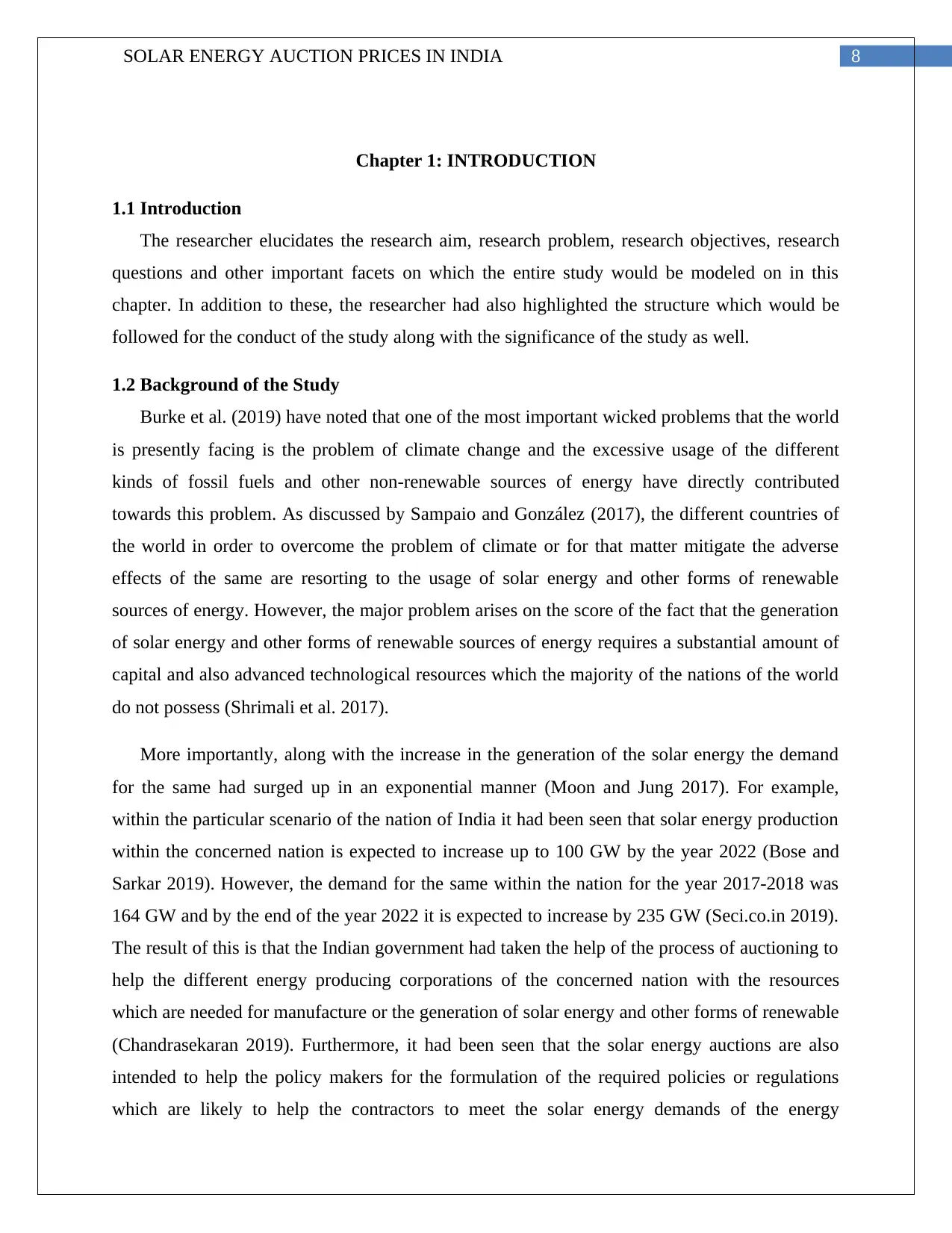
8SOLAR ENERGY AUCTION PRICES IN INDIA
Chapter 1: INTRODUCTION
1.1 Introduction
The researcher elucidates the research aim, research problem, research objectives, research
questions and other important facets on which the entire study would be modeled on in this
chapter. In addition to these, the researcher had also highlighted the structure which would be
followed for the conduct of the study along with the significance of the study as well.
1.2 Background of the Study
Burke et al. (2019) have noted that one of the most important wicked problems that the world
is presently facing is the problem of climate change and the excessive usage of the different
kinds of fossil fuels and other non-renewable sources of energy have directly contributed
towards this problem. As discussed by Sampaio and González (2017), the different countries of
the world in order to overcome the problem of climate or for that matter mitigate the adverse
effects of the same are resorting to the usage of solar energy and other forms of renewable
sources of energy. However, the major problem arises on the score of the fact that the generation
of solar energy and other forms of renewable sources of energy requires a substantial amount of
capital and also advanced technological resources which the majority of the nations of the world
do not possess (Shrimali et al. 2017).
More importantly, along with the increase in the generation of the solar energy the demand
for the same had surged up in an exponential manner (Moon and Jung 2017). For example,
within the particular scenario of the nation of India it had been seen that solar energy production
within the concerned nation is expected to increase up to 100 GW by the year 2022 (Bose and
Sarkar 2019). However, the demand for the same within the nation for the year 2017-2018 was
164 GW and by the end of the year 2022 it is expected to increase by 235 GW (Seci.co.in 2019).
The result of this is that the Indian government had taken the help of the process of auctioning to
help the different energy producing corporations of the concerned nation with the resources
which are needed for manufacture or the generation of solar energy and other forms of renewable
(Chandrasekaran 2019). Furthermore, it had been seen that the solar energy auctions are also
intended to help the policy makers for the formulation of the required policies or regulations
which are likely to help the contractors to meet the solar energy demands of the energy
Chapter 1: INTRODUCTION
1.1 Introduction
The researcher elucidates the research aim, research problem, research objectives, research
questions and other important facets on which the entire study would be modeled on in this
chapter. In addition to these, the researcher had also highlighted the structure which would be
followed for the conduct of the study along with the significance of the study as well.
1.2 Background of the Study
Burke et al. (2019) have noted that one of the most important wicked problems that the world
is presently facing is the problem of climate change and the excessive usage of the different
kinds of fossil fuels and other non-renewable sources of energy have directly contributed
towards this problem. As discussed by Sampaio and González (2017), the different countries of
the world in order to overcome the problem of climate or for that matter mitigate the adverse
effects of the same are resorting to the usage of solar energy and other forms of renewable
sources of energy. However, the major problem arises on the score of the fact that the generation
of solar energy and other forms of renewable sources of energy requires a substantial amount of
capital and also advanced technological resources which the majority of the nations of the world
do not possess (Shrimali et al. 2017).
More importantly, along with the increase in the generation of the solar energy the demand
for the same had surged up in an exponential manner (Moon and Jung 2017). For example,
within the particular scenario of the nation of India it had been seen that solar energy production
within the concerned nation is expected to increase up to 100 GW by the year 2022 (Bose and
Sarkar 2019). However, the demand for the same within the nation for the year 2017-2018 was
164 GW and by the end of the year 2022 it is expected to increase by 235 GW (Seci.co.in 2019).
The result of this is that the Indian government had taken the help of the process of auctioning to
help the different energy producing corporations of the concerned nation with the resources
which are needed for manufacture or the generation of solar energy and other forms of renewable
(Chandrasekaran 2019). Furthermore, it had been seen that the solar energy auctions are also
intended to help the policy makers for the formulation of the required policies or regulations
which are likely to help the contractors to meet the solar energy demands of the energy
⊘ This is a preview!⊘
Do you want full access?
Subscribe today to unlock all pages.

Trusted by 1+ million students worldwide
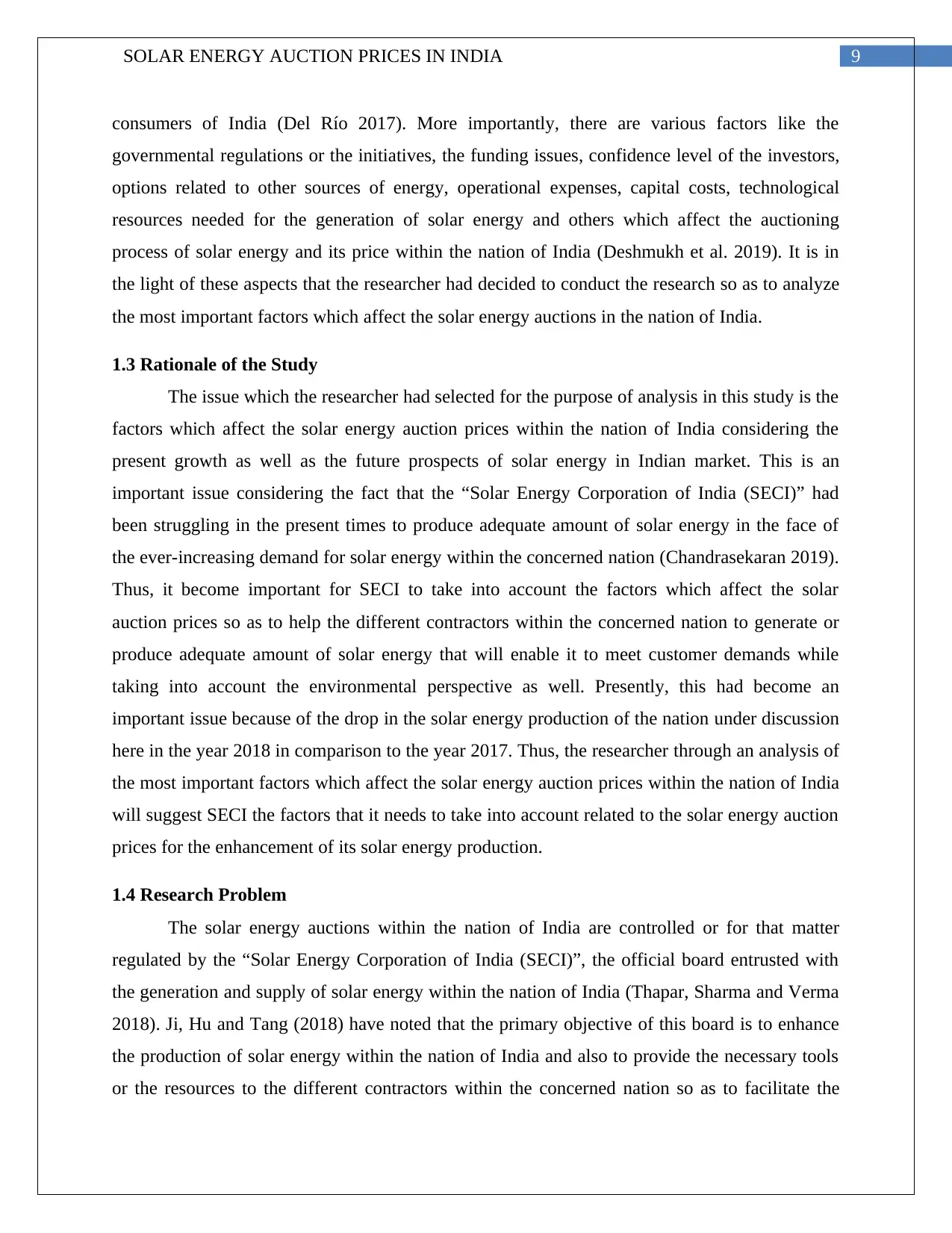
9SOLAR ENERGY AUCTION PRICES IN INDIA
consumers of India (Del Río 2017). More importantly, there are various factors like the
governmental regulations or the initiatives, the funding issues, confidence level of the investors,
options related to other sources of energy, operational expenses, capital costs, technological
resources needed for the generation of solar energy and others which affect the auctioning
process of solar energy and its price within the nation of India (Deshmukh et al. 2019). It is in
the light of these aspects that the researcher had decided to conduct the research so as to analyze
the most important factors which affect the solar energy auctions in the nation of India.
1.3 Rationale of the Study
The issue which the researcher had selected for the purpose of analysis in this study is the
factors which affect the solar energy auction prices within the nation of India considering the
present growth as well as the future prospects of solar energy in Indian market. This is an
important issue considering the fact that the “Solar Energy Corporation of India (SECI)” had
been struggling in the present times to produce adequate amount of solar energy in the face of
the ever-increasing demand for solar energy within the concerned nation (Chandrasekaran 2019).
Thus, it become important for SECI to take into account the factors which affect the solar
auction prices so as to help the different contractors within the concerned nation to generate or
produce adequate amount of solar energy that will enable it to meet customer demands while
taking into account the environmental perspective as well. Presently, this had become an
important issue because of the drop in the solar energy production of the nation under discussion
here in the year 2018 in comparison to the year 2017. Thus, the researcher through an analysis of
the most important factors which affect the solar energy auction prices within the nation of India
will suggest SECI the factors that it needs to take into account related to the solar energy auction
prices for the enhancement of its solar energy production.
1.4 Research Problem
The solar energy auctions within the nation of India are controlled or for that matter
regulated by the “Solar Energy Corporation of India (SECI)”, the official board entrusted with
the generation and supply of solar energy within the nation of India (Thapar, Sharma and Verma
2018). Ji, Hu and Tang (2018) have noted that the primary objective of this board is to enhance
the production of solar energy within the nation of India and also to provide the necessary tools
or the resources to the different contractors within the concerned nation so as to facilitate the
consumers of India (Del Río 2017). More importantly, there are various factors like the
governmental regulations or the initiatives, the funding issues, confidence level of the investors,
options related to other sources of energy, operational expenses, capital costs, technological
resources needed for the generation of solar energy and others which affect the auctioning
process of solar energy and its price within the nation of India (Deshmukh et al. 2019). It is in
the light of these aspects that the researcher had decided to conduct the research so as to analyze
the most important factors which affect the solar energy auctions in the nation of India.
1.3 Rationale of the Study
The issue which the researcher had selected for the purpose of analysis in this study is the
factors which affect the solar energy auction prices within the nation of India considering the
present growth as well as the future prospects of solar energy in Indian market. This is an
important issue considering the fact that the “Solar Energy Corporation of India (SECI)” had
been struggling in the present times to produce adequate amount of solar energy in the face of
the ever-increasing demand for solar energy within the concerned nation (Chandrasekaran 2019).
Thus, it become important for SECI to take into account the factors which affect the solar
auction prices so as to help the different contractors within the concerned nation to generate or
produce adequate amount of solar energy that will enable it to meet customer demands while
taking into account the environmental perspective as well. Presently, this had become an
important issue because of the drop in the solar energy production of the nation under discussion
here in the year 2018 in comparison to the year 2017. Thus, the researcher through an analysis of
the most important factors which affect the solar energy auction prices within the nation of India
will suggest SECI the factors that it needs to take into account related to the solar energy auction
prices for the enhancement of its solar energy production.
1.4 Research Problem
The solar energy auctions within the nation of India are controlled or for that matter
regulated by the “Solar Energy Corporation of India (SECI)”, the official board entrusted with
the generation and supply of solar energy within the nation of India (Thapar, Sharma and Verma
2018). Ji, Hu and Tang (2018) have noted that the primary objective of this board is to enhance
the production of solar energy within the nation of India and also to provide the necessary tools
or the resources to the different contractors within the concerned nation so as to facilitate the
Paraphrase This Document
Need a fresh take? Get an instant paraphrase of this document with our AI Paraphraser
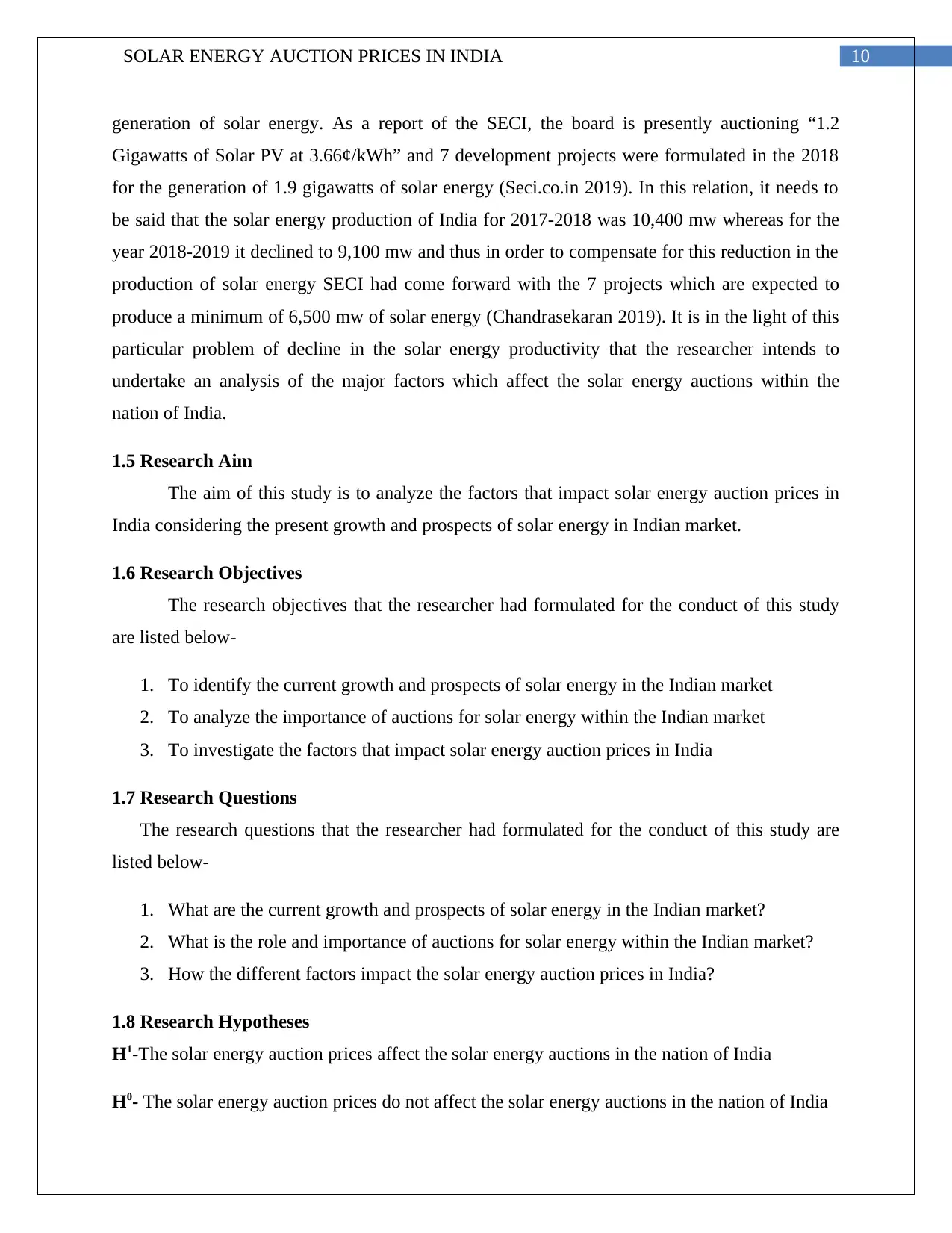
10SOLAR ENERGY AUCTION PRICES IN INDIA
generation of solar energy. As a report of the SECI, the board is presently auctioning “1.2
Gigawatts of Solar PV at 3.66¢/kWh” and 7 development projects were formulated in the 2018
for the generation of 1.9 gigawatts of solar energy (Seci.co.in 2019). In this relation, it needs to
be said that the solar energy production of India for 2017-2018 was 10,400 mw whereas for the
year 2018-2019 it declined to 9,100 mw and thus in order to compensate for this reduction in the
production of solar energy SECI had come forward with the 7 projects which are expected to
produce a minimum of 6,500 mw of solar energy (Chandrasekaran 2019). It is in the light of this
particular problem of decline in the solar energy productivity that the researcher intends to
undertake an analysis of the major factors which affect the solar energy auctions within the
nation of India.
1.5 Research Aim
The aim of this study is to analyze the factors that impact solar energy auction prices in
India considering the present growth and prospects of solar energy in Indian market.
1.6 Research Objectives
The research objectives that the researcher had formulated for the conduct of this study
are listed below-
1. To identify the current growth and prospects of solar energy in the Indian market
2. To analyze the importance of auctions for solar energy within the Indian market
3. To investigate the factors that impact solar energy auction prices in India
1.7 Research Questions
The research questions that the researcher had formulated for the conduct of this study are
listed below-
1. What are the current growth and prospects of solar energy in the Indian market?
2. What is the role and importance of auctions for solar energy within the Indian market?
3. How the different factors impact the solar energy auction prices in India?
1.8 Research Hypotheses
H1-The solar energy auction prices affect the solar energy auctions in the nation of India
H0- The solar energy auction prices do not affect the solar energy auctions in the nation of India
generation of solar energy. As a report of the SECI, the board is presently auctioning “1.2
Gigawatts of Solar PV at 3.66¢/kWh” and 7 development projects were formulated in the 2018
for the generation of 1.9 gigawatts of solar energy (Seci.co.in 2019). In this relation, it needs to
be said that the solar energy production of India for 2017-2018 was 10,400 mw whereas for the
year 2018-2019 it declined to 9,100 mw and thus in order to compensate for this reduction in the
production of solar energy SECI had come forward with the 7 projects which are expected to
produce a minimum of 6,500 mw of solar energy (Chandrasekaran 2019). It is in the light of this
particular problem of decline in the solar energy productivity that the researcher intends to
undertake an analysis of the major factors which affect the solar energy auctions within the
nation of India.
1.5 Research Aim
The aim of this study is to analyze the factors that impact solar energy auction prices in
India considering the present growth and prospects of solar energy in Indian market.
1.6 Research Objectives
The research objectives that the researcher had formulated for the conduct of this study
are listed below-
1. To identify the current growth and prospects of solar energy in the Indian market
2. To analyze the importance of auctions for solar energy within the Indian market
3. To investigate the factors that impact solar energy auction prices in India
1.7 Research Questions
The research questions that the researcher had formulated for the conduct of this study are
listed below-
1. What are the current growth and prospects of solar energy in the Indian market?
2. What is the role and importance of auctions for solar energy within the Indian market?
3. How the different factors impact the solar energy auction prices in India?
1.8 Research Hypotheses
H1-The solar energy auction prices affect the solar energy auctions in the nation of India
H0- The solar energy auction prices do not affect the solar energy auctions in the nation of India
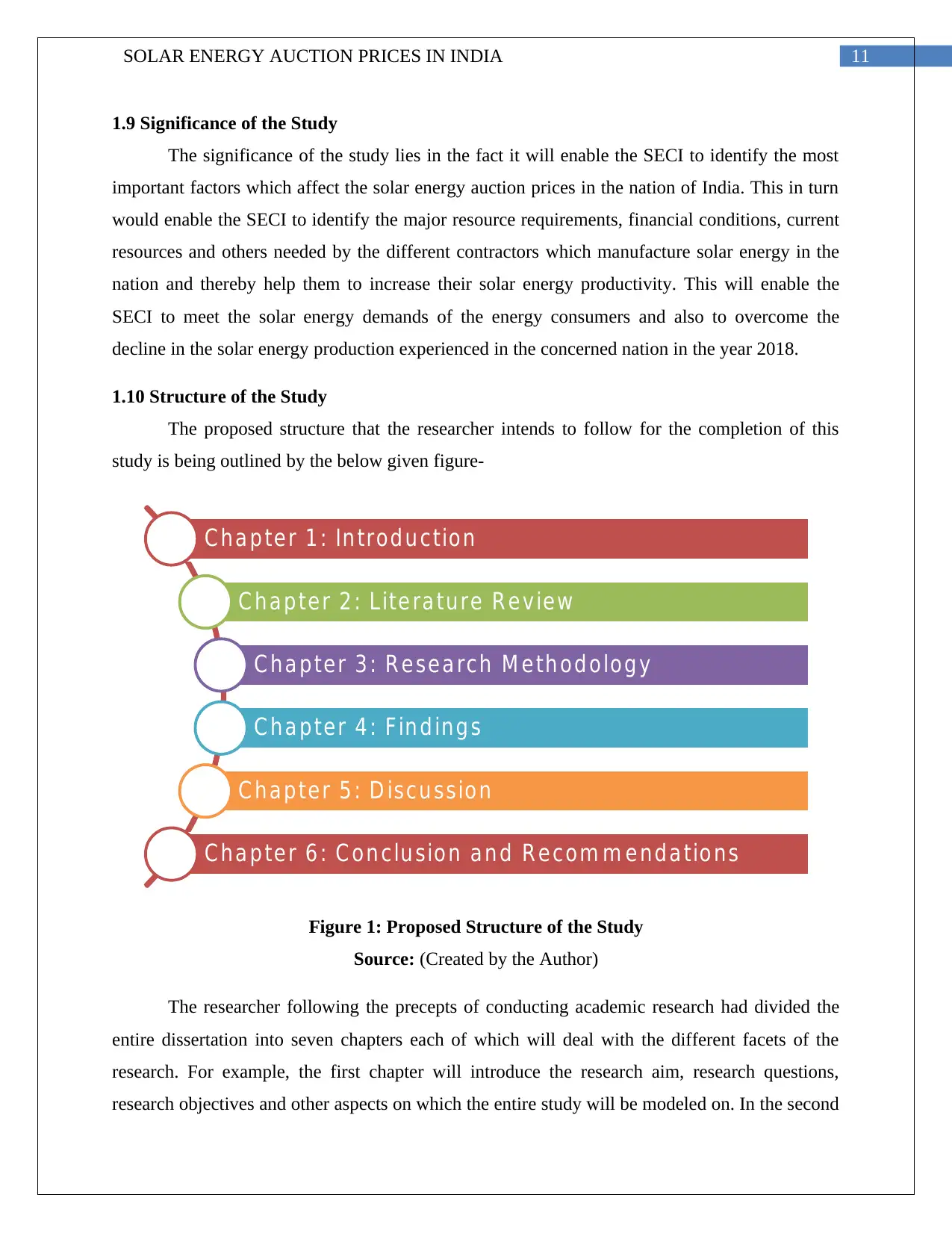
11SOLAR ENERGY AUCTION PRICES IN INDIA
1.9 Significance of the Study
The significance of the study lies in the fact it will enable the SECI to identify the most
important factors which affect the solar energy auction prices in the nation of India. This in turn
would enable the SECI to identify the major resource requirements, financial conditions, current
resources and others needed by the different contractors which manufacture solar energy in the
nation and thereby help them to increase their solar energy productivity. This will enable the
SECI to meet the solar energy demands of the energy consumers and also to overcome the
decline in the solar energy production experienced in the concerned nation in the year 2018.
1.10 Structure of the Study
The proposed structure that the researcher intends to follow for the completion of this
study is being outlined by the below given figure-
Figure 1: Proposed Structure of the Study
Source: (Created by the Author)
The researcher following the precepts of conducting academic research had divided the
entire dissertation into seven chapters each of which will deal with the different facets of the
research. For example, the first chapter will introduce the research aim, research questions,
research objectives and other aspects on which the entire study will be modeled on. In the second
C h a p te r 1 : In tro d u c tio n
C h a p te r 2 : L ite ra tu re R e v ie w
C h a p te r 3 : R e s e a rc h M e th o d o lo g y
C h a p te r 4 : F in d in g s
C h a p te r 5 : D is c u s s io n
C h a p te r 6 : C o n c lu sio n a n d R e c o m m e n d a tio n s
1.9 Significance of the Study
The significance of the study lies in the fact it will enable the SECI to identify the most
important factors which affect the solar energy auction prices in the nation of India. This in turn
would enable the SECI to identify the major resource requirements, financial conditions, current
resources and others needed by the different contractors which manufacture solar energy in the
nation and thereby help them to increase their solar energy productivity. This will enable the
SECI to meet the solar energy demands of the energy consumers and also to overcome the
decline in the solar energy production experienced in the concerned nation in the year 2018.
1.10 Structure of the Study
The proposed structure that the researcher intends to follow for the completion of this
study is being outlined by the below given figure-
Figure 1: Proposed Structure of the Study
Source: (Created by the Author)
The researcher following the precepts of conducting academic research had divided the
entire dissertation into seven chapters each of which will deal with the different facets of the
research. For example, the first chapter will introduce the research aim, research questions,
research objectives and other aspects on which the entire study will be modeled on. In the second
C h a p te r 1 : In tro d u c tio n
C h a p te r 2 : L ite ra tu re R e v ie w
C h a p te r 3 : R e s e a rc h M e th o d o lo g y
C h a p te r 4 : F in d in g s
C h a p te r 5 : D is c u s s io n
C h a p te r 6 : C o n c lu sio n a n d R e c o m m e n d a tio n s
⊘ This is a preview!⊘
Do you want full access?
Subscribe today to unlock all pages.

Trusted by 1+ million students worldwide
1 out of 60
Related Documents
Your All-in-One AI-Powered Toolkit for Academic Success.
+13062052269
info@desklib.com
Available 24*7 on WhatsApp / Email
![[object Object]](/_next/static/media/star-bottom.7253800d.svg)
Unlock your academic potential
Copyright © 2020–2025 A2Z Services. All Rights Reserved. Developed and managed by ZUCOL.





